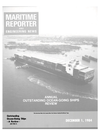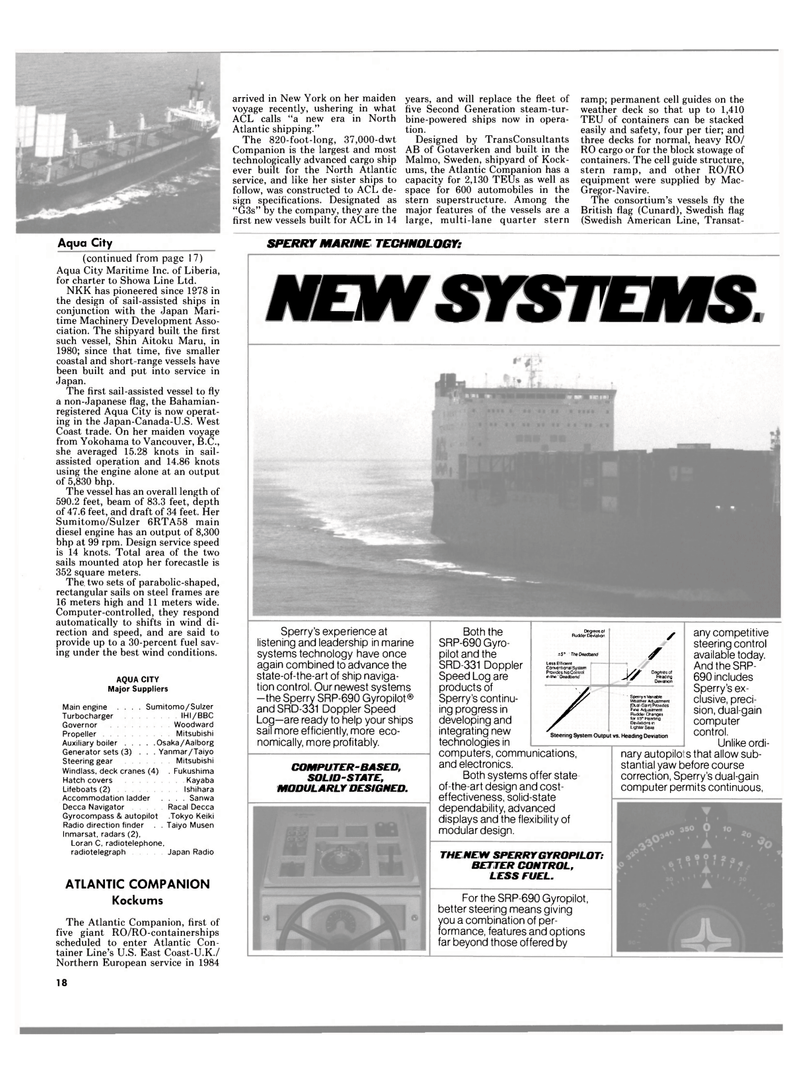
Page 16: of Maritime Reporter Magazine (December 1984)
Read this page in Pdf, Flash or Html5 edition of December 1984 Maritime Reporter Magazine
Aqua City arrived in New York on her maiden voyage recently, ushering in what
ACL calls "a new era in North
Atlantic shipping."
The 820-foot-long, 37,000-dwt
Companion is the largest and most technologically advanced cargo ship ever built for the North Atlantic service, and like her sister ships to follow, was constructed to ACL de- sign specifications. Designated as "G3s" by the company, they are the first new vessels built for ACL in 14 years, and will replace the fleet of five Second Generation steam-tur- bine-powered ships now in opera- tion.
Designed by TransConsultants
AB of Gotaverken and built in the
Malmo, Sweden, shipyard of Kock- ums, the Atlantic Companion has a capacity for 2,130 TEUs as well as space for 600 automobiles in the stern superstructure. Among the major features of the vessels are a large, multi-lane quarter stern ramp; permanent cell guides on the weather deck so that up to 1,410
TEU of containers can be stacked easily and safety, four per tier; and three decks for normal, heavy RO/
RO cargo or for the block stowage of containers. The cell guide structure, stern ramp, and other RO/RO equipment were supplied by Mac-
Gregor-Navire.
The consortium's vessels fly the
British flag (Cunard), Swedish flag (Swedish American Line, Transat- (continued from page 17)
Aqua City Maritime Inc. of Liberia, for charter to Showa Line Ltd.
NKK has pioneered since 1978 in the design of sail-assisted ships in conjunction with the Japan Mari- time Machinery Development Asso- ciation. The shipyard built the first such vessel, Shin Aitoku Maru, in 1980; since that time, five smaller coastal and short-range vessels have been built and put into service in
Japan.
The first sail-assisted vessel to fly a non-Japanese flag, the Bahamian- registered Aqua City is now operat- ing in the Japan-Canada-U.S. West
Coast trade. On her maiden voyage from Yokohama to Vancouver, B.C., she averaged 15.28 knots in sail- assisted operation and 14.86 knots using the engine alone at an output of 5,830 bhp.
The vessel has an overall length of 590.2 feet, beam of 83.3 feet, depth of 47.6 feet, and draft of 34 feet. Her
Sumitomo/Sulzer 6RTA58 main diesel engine has an output of 8,300 bhp at 99 rpm. Design service speed is 14 knots. Total area of the two sails mounted atop her forecastle is 352 square meters.
The, two sets of parabolic-shaped, rectangular sails on steel frames are 16 meters high and 11 meters wide.
Computer-controlled, they respond automatically to shifts in wind di- rection and speed, and are said to provide up to a 30-percent fuel sav- ing under the best wind conditions.
AQUA CITY
Major Suppliers
Main engine .... Sumitomo/Sulzer
Turbocharger IHI/BBC
Governor Woodward
Propeller Mitsubishi
Auxiliary boiler Osaka/Aalborg
Generator sets (3) ... Yanmar/Taiyo
Steering gear Mitsubishi
Windlass, deck cranes (4) . Fukushima
Hatch covers Kayab
Lifeboats (2) Ishihara
Accommodation ladder .... Sanwa
Decca Navigator Racal Decca
Gyrocompass & autopilot .Tokyo Keiki
Radio direction finder . . Taiyo Musen
Inmarsat, radars (2),
Loran C, radiotelephone, radiotelegraph Japan Radio
ATLANTIC COMPANION
Kockums
The Atlantic Companion, first of five giant RO/RO-containerships scheduled to enter Atlantic Con- tainer Line's U.S. East Coast-U.K./
Northern European service in 1984
SPERRY MARINE TECHNOLOGY:
MEW SYSTEMS.
Sperry's experience at listening and leadership in marine systems technology have once again comPined to advance the state-of-the-art of ship naviga- tion control. Our newest systems -the Sperry SRP-690 Gyropilot® and SRD-331 Doppler Speed
Log—are ready to help your ships sail more efficiently, more eco- nomically, more profitably.
COMPUTER-BASED,
SOLID-STATE,
MODULARLY DESIGNED.
Both the
SRP-690 Gyro- pilot and the
SRD-331 Doppler
Speed Log are products of
Sperry's continu- ing progress in developing and integrating new technologies in computers, communications, and electronics.
Both systems offer state of-the-art design and cost- effectiveness, solid-state dependability, advanced displays and the flexibility of modular design.
Degrees of
Rudder Deviation / ±5°r'TheDeadband /
Less Efficient
Conventional System
Provides No Control ! nthe Oeadband' j ^r \ DSgtees of ^jff Heading
Deviation / ~ Sperry s Variable
Weather Adjustment ; (Dudl-Gaih) Provides ;
Fine-Adjustment
Rudder Changes for ±5° Heading
Devlatidns ih; '
Lighter Seas
Steering System Output vs. Heading Deviation
THE NEW SPERRY GYROPILOT:
BETTER CONTROL,
LESS FUEL.
For the SRP-690 Gyropilot, better steering means giving you a combination of per- formance, features and options far beyond those offered by any competitive steering control available today.
And the SRP- 690 includes
Sperry's ex- clusive, preci- sion, dual-gain computer control.
Unlike ordi- nary autopilots that allow sub- stantial yaw before course correction, Sperry's dual-gain computer permits continuous, 18

 15
15

 17
17
